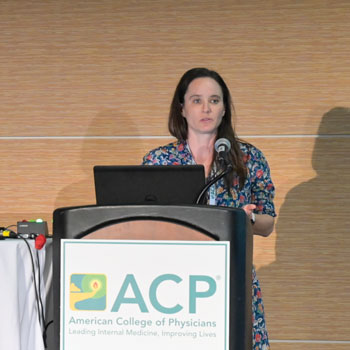Treating obesity as a disease
Obesity stems from genetics and environmental factors, but bias by physicians and the public may interfere with treating it as a disease.
More than two in five U.S. adults live with obesity, but a host of environmental and genetic factors put some populations at greater risk than others.
To address this issue, physicians should adopt a health equity lens when caring for patients with obesity, according to three experts who spoke on the topic at Internal Medicine Meeting 2024.

During "Advancing Equitable Approaches to Improve Obesity Care," a session sponsored by ACP's Council of Subspecialty Societies, moderator Alicia I. Arbaje, MD, MPH, PhD, FACP, hosted a discussion with Melanie Jay, MD, MS, and Ana María López, MD, MPH, MACP, who outlined disparities in current obesity trends, advised attendees on how to reduce stigma and misinformation, and offered tips on improving empathy during patient interactions.
The first step to meet these goals is to recognize obesity as a chronic disease, they said.
Stigma and disparities
Obesity is a disease of excess adiposity that may lead to structural and functional abnormalities, elevated mortality risk, and increased comorbidity risk, explained Dr. Jay, associate professor of medicine and population health at New York University Grossman School of Medicine.
And, "like any other disease, it is caused by interactions with our genes and our environment and our behaviors," Dr. Jay said. This is important to note because many Americans and physicians falsely believe the condition is driven by individuals' personal choices, she said.
During her presentation, Dr. Jay cited an April 2006 report from Pew Research Center that found nearly 60% of Americans believe obesity is caused by lack of willpower and only 32% believe genetics is important in developing the condition.
In reality, obesity has over 120 loci genetically, Dr. Jay said. Its heritability ranges from 40% to 70%, according to research published in October 2010 in Current Diabetes Reports, a percentage similar to height and higher than that for heart disease, she explained, stressing that personal choice plays a small role in obesity development.
Despite this, "health care providers have the same levels of anti-fat biases as the general population and patients report feeling stigmatized in health care settings," said Dr. Jay.
Nearly 20% of individuals with class 1 obesity (defined as a body mass index [BMI] of 30 to 35 kg/m2) have experienced weight discrimination, according to research published in the January 2016 Obesity Reviews. But that total increases to 42% among individuals with class 2/3 obesity (BMI >35 kg/m2).
"The big thing about stigma is that it makes people feel ineffective," said Dr. López, an integrative oncologist and professor of medical oncology at Sidney Kimmel Cancer Center in Philadelphia.
"We want people to feel engaged and feel like 'I can.' You want people to feel activated. But when they feel demoralized, which … I think is impactful for so many of our underserved, underrepresented, under-everything communities, it's that sense of 'I can't.'"
Disparities in obesity rates are stark and the disease is more prevalent in underserved populations, experts said. Environmental factors like food environments, physical activity levels, and chemical exposures all contribute to obesity risk and heighten disparities.
While more than 40% of all U.S. adults have obesity, that rate is closer to 50% in non-Hispanic Black adults and is almost 45% in Hispanic adults, Dr. Jay said. Prevalence is also higher in groups with lower educational attainment and income levels. Obesity is more common in lesbian and bisexual women compared with heterosexual women, in patients with severe mental illness, and in veterans, she added. "So a lot of our patients who are already vulnerable have increased risk of obesity."
Disparities are also evident in treatment outcomes, an issue that's likely driven by access barriers, Dr. Jay continued. Underrepresentation of at-risk populations in research compounds the problem. "African American men represent less than 2% of our participants in weight loss studies in the United States," she said.
Social determinants of health play a large role in obesity risk as well, with factors like individual discrimination and structural mechanisms, including redlining, impacting patients' outcomes, she added.
However, recognizing the myriad factors that contribute to obesity, accepting that it's not solely a result of personal choice, and acknowledging obesity as a disease are all steps physicians can take to reduce stigma and provide empathetic care for patients, the panelists stressed.
To illustrate just how harmful stigma can be, Dr. Jay pulled up a slide of a cartoon person impaled with a plank of wood. In the image, the patient exclaims, "Doctor! I've been impaled," only for the physician to remark, without looking up from his notes, "Well maybe you'll feel better if you lose some weight."
"That exemplifies how a lot of our patients feel when we just tell them, 'Well, come back when you've lost some weight,'" Dr. Jay said.
Dr. Jay offered tips for physicians to provide better patient-centered obesity care. These include calling out stigma when they witness it, recognizing when a person with obesity comes into the office that they've likely experienced stigma and acknowledging that fact, and asking permission to discuss weight with the patient.
"We don't want to blame the patient or shame them because that doesn't help, and we want to train our students and residents to model best practices. How we talk about our patients when they're not in the room to our trainees is very important," she said.
Dr. Arbaje, associate professor of medicine and director of transitional care research at Johns Hopkins University School of Medicine in Baltimore and Chair of ACP's Council of Subspecialty Societies, agreed. While one-third of her patients with obesity may present to the hospital with congestive heart failure, another third with diabetes, and another third with delirium, "100% of the patients that come into the hospital have guilt and shame around their condition," she said. "Attending to where people are when they first are in your office or in the hospital I think can really go a long way to building trust and then eventually leading to empowerment."
Interventions and management
In the latter half of the session, Dr. López discussed how weight impacts patients' health outside of traditional concerns like diabetes and cardiovascular disease.
"More than 10% of early deaths are thought to be attributable to excess weight. So more than one in 10, closer to one in eight preventable deaths. That's a lot of prevention," she said. "What we're really talking about is metabolic health."
Patients' blood glucose levels, HbA1c, lipids, and hypertension are all important data points, Dr. López added. "Probably every cancer is linked to metabolic health at some level, because of the link with inflammation. Metabolic illness increases inflammation; inflammation increases cancer risk," she said.
There are 13 cancers known to be associated with being overweight, and for the first time in more than a decade, rates of cancer are anticipated to increase in 2024, Dr. López said. Addressing obesity may help slow or reverse this trend.
"When we think about cancer survivorship, when we think about cancer risk, we have to think that the prevention and treatment of obesity is a modifiable factor for cancer etiology. And in that sense, we're all obesity doctors," Dr. López said.
Research published by JAMA in June 2022 found that bariatric surgery in patients with obesity was associated with a significantly lower risk of both obesity-associated cancer (hazard ratio [HR], 0.68) and cancer-related mortality (HR, 0.52), compared with patients who did not undergo surgery. Findings were consistent regardless of surgery type (Roux-en-Y gastric bypass or sleeve gastrectomy).
"So, bariatric surgery is part of cancer therapy," Dr. López said.
There are multiple additional intervention points for obesity, ranging from individual to policy-level actions, she noted. These can include lifestyle modifications and pharmacotherapy, along with patient group visits, increasing access to healthy, affordable food, and countering public misinformation about obesity.
"The empowerment and the enlisting [of the] patient as partner is really critical," Dr. López said.
Even though "the causes of obesity are not always completely in the person's control … like any other disease that has to be managed chronically, we need very active approaches from our patients," said Dr. Jay. "We don't think of cancer as being caused always by things in our control. And yet it takes a lot of empowerment to address it."
Keeping obesity disparities and risk factors in mind can also help physicians provide better patient-tailored care.
For example, BMI has historically been used to classify obesity, but experts caution that the metric is imperfect and can have different meanings in different populations. To get a more accurate picture of overweight and obesity, physicians could measure waist circumference instead. A healthy waist circumference is less than half of a person's height, Dr. López said. Another option is to measure waist-to-hip ratio.
Tailoring patient care can also include asking individuals what matters most to them and what they want to address with treatment.
"We want people to feel good in their bodies … people can feel appreciation for their bodies and feel that steps need to be taken for health," Dr. López said.
More work needed
Last October, the Council of Subspecialty Societies convened more than 20 stakeholder organizations in Philadelphia at the "Unify Efforts to Empower Equitable Obesity Care" summit. Ensuring all populations have access to patient-centered obesity care, making obesity care as common as hypertension treatment, and creating a stigma-free culture were among the goals identified at the summit.
According to Dr. Arbaje, the priorities outlined by the panelists align with these goals and require paradigm shifts to improve care for patients with obesity. These include changes in language used to talk about obesity, a broader mindset about the condition's contributors, and shifts in physicians' measures of obesity, she said.
On the policy front, Dr. Jay highlighted successful efforts by doctors advocating for Medicaid coverage of obesity care and coverage for military personnel and veterans. Nationally, "we can support the Treat and Reduce Obesity Act for Medicare coverage of obesity treatment," she added.
Going forward, additional actions needed include improving training for physicians and health professionals, using the media to dispel obesity stigma and raise awareness about equitable care, and conducting research to address obesity disparities, Dr. Jay said.
When looking at what care is and isn't covered across the country, "I can't help but think that stigma is part of that in terms of what things in our society we're deciding should be addressed," she continued. "As we think about obesity as a disease and having more and more evidence for that, that hopefully [will lead to] policies where insurance can cover it."



